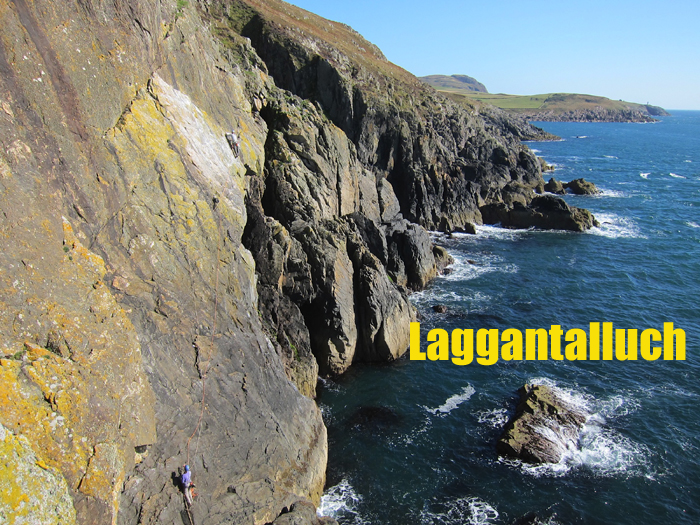
Introduction Laggantalluch Head is an area
of diorite (a rock like fine granite) sea-cliffs south of Stranraer. They lie on the coast of the North Channel near
the Mull of Galloway. The crag is often warm and sunny when much of
Scotland, or even Galloway is wet!
Pictured above are myself and Linda on Stingray,
on a day when much of Scotland was damp, cold and dreich!
Access The crags are mostly tidal, but many routes are still accessible at high tide and some completely on dry land. To get here follow the A77 or A75 towards Stranraer then the A716 down the east shore of the Rhins to Drummore village. From here follow the B7041 then an unnamed minor road westwards to Portencorkrie Bay. A wee track runs down to the shore between Knockenculie and Barncorkrie farms. About 50m before the derelict cottage cross the fence and burn and head north. Cut across two grassy fields to the north, rising slightly to reach a fence line running northwards (parallel to the shore) about 60m above sea level (fence is marked on the 1:25,000 OS map). Follow this fence. When the fence turns sharp right leave it and go diagonally down the slope to reach the top of the main cliff. A total walk of about 15-20 minutes from the road to reach the crags. This approach route at first appears to climb much higher than necessary, but it is the best way in. You can also walk closer to the shore around from the derelict cottage to the crags, but it's much rougher walking, and you'll eventually get to a big dry zawn that forces you a lot higher anyway.
Guidebook For a definitive list of all the climbs at Laggantalluch Head see the SMC published Lowland Outcrops guidebook.
Birds Sea birds (mainly gulls can be a problem here into late July. The numbers seem to be very variable by year.
Dangers This is a granite sea cliff with generally good rock, but areas of dubious rock do exist on the bigger cliffs. Almost all the routes require abseil approaches, so are serious in nature and can be difficult to locate. Some of the slabby routes are difficult to protect as the granite can be very compact - a good rack of micro-wires and some small cams are recommended, as well as a steady head. This is a very open stretch of coast so the crag will be hazardous in big seas or high winds and the area is very open to rapid weather changes.
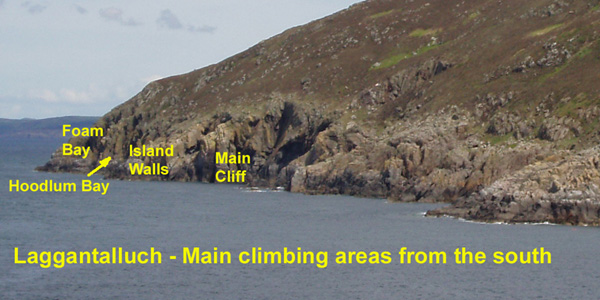
Main Cliff
The climbs at Laggantalluch detailed here are described from south to north, starting with the biggest and best area, appropriately called Main Cliff.
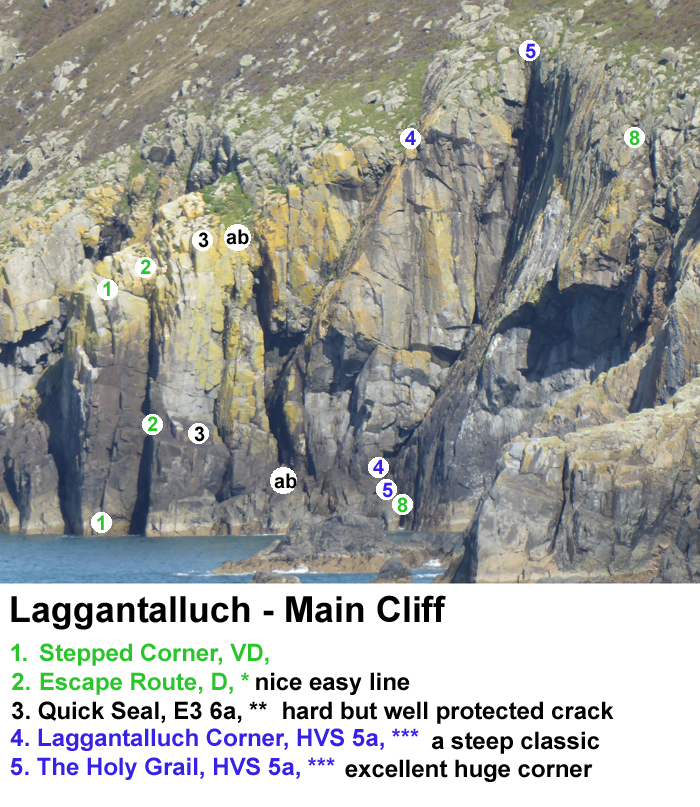
The main cliff has routes to 60m on the big slab on the right, and to 25m or so on the steep walls and fins to the left. There is a nice grassy hollow at the top of the usual abseil. Abseil off a big spike (super size sling ideal) down a pigeon-filled slot for 15-20m. The various landing platforms are nice and flat and above all but the very highest tide lines. Not far to the right of the abseil line the classic line on the main cliff is 4. Laggantalluch Corner, HVS 5a ***, pictured below. It's a well protected route and not as strenuous as it first looks.
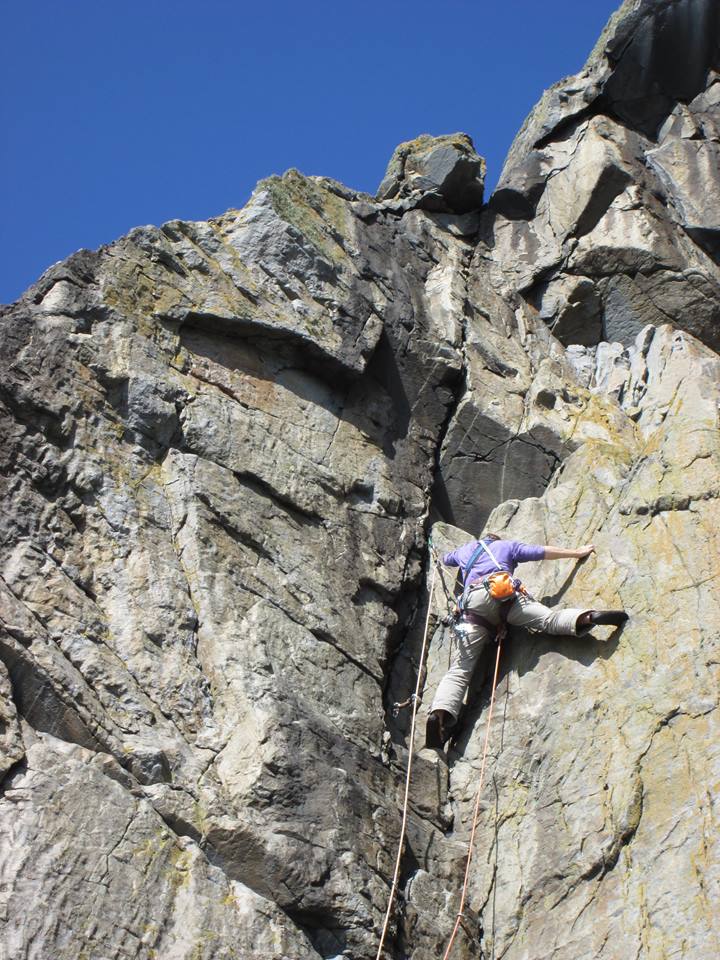
A bit further right is the massive corner of The Holy Grail, HVS 5a, ***. It is easier than Laggantalluch Corner but still with some excellent climbing. There are sometimes wet streaks on the initial slab, but these do not affect the crucial holds and the top two steep corners are usually dry. Picture below is Linda Biggar just below the crux.
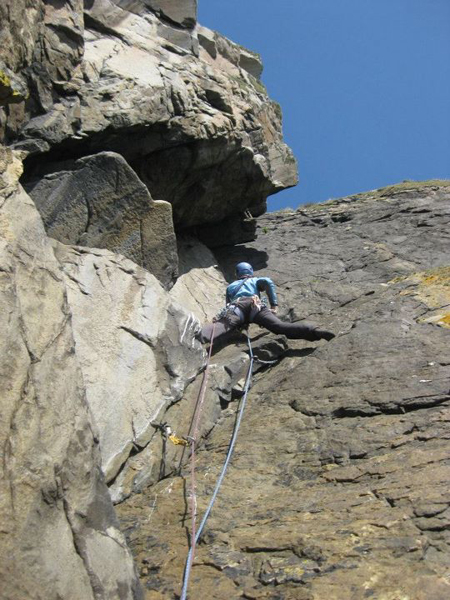
To the right again is the main slab itself, often with poor protection. One or two of the routes are a bit lichenous at the top as well, but generally this does not affect the climbing too badly. Stingray is particularly nice, but it is a serious climb to second due to the potential of a big pendulum fall into space above the sea! The photo below is massively foreshortened, Stingray is a single pitch nearly 60m long, with no real halfway belay option.
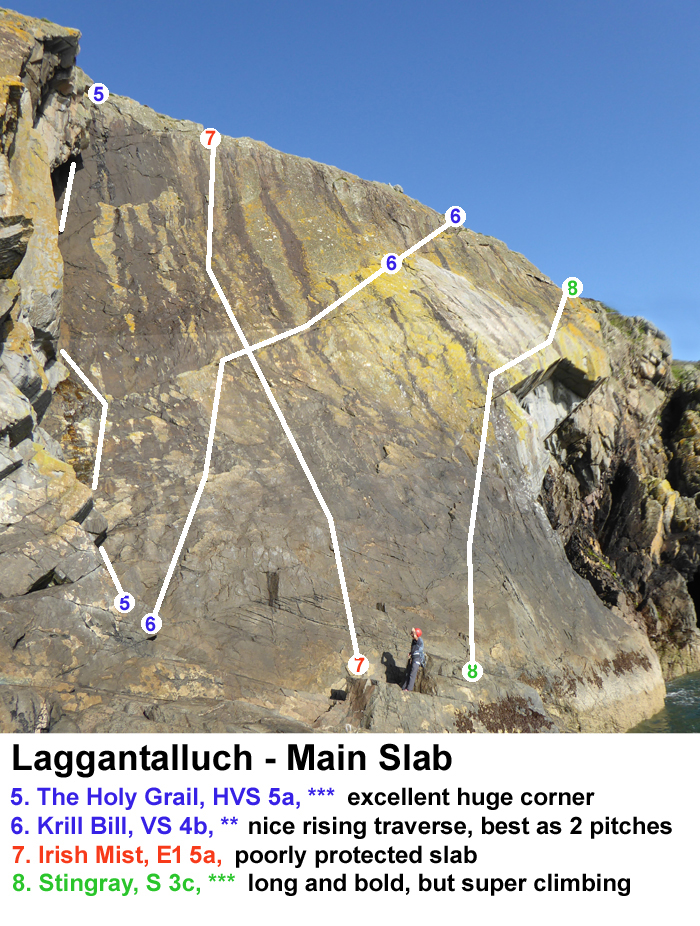
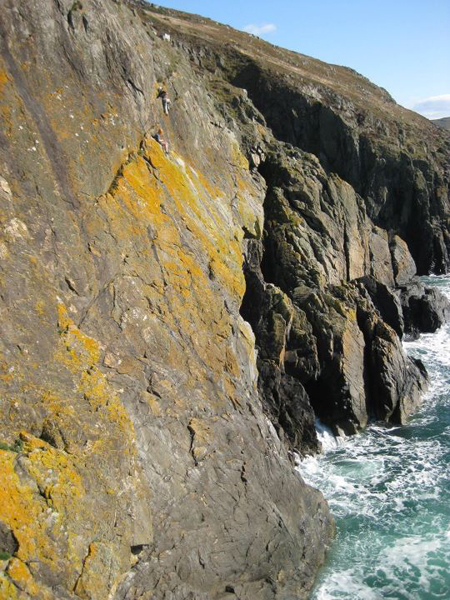
Climbers at the belay on Krill Bill.
Lunch Bay
Immediately north of the main cliff is Lunch Bay, with a number of routes on a south facing wall. Access by scrambling carefully down the easy slab from above the abseil point for the Main Cliff.
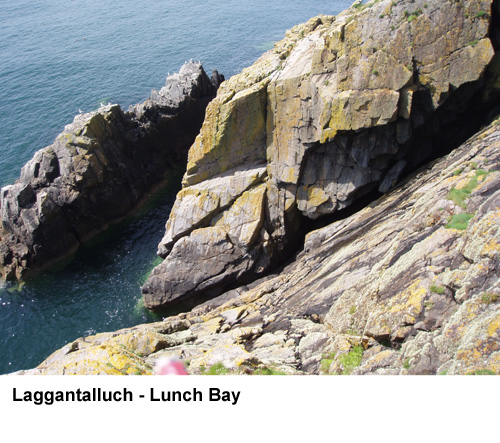
Island Walls
This is probably the least serious area of Laggantalluch and a good introduction to the area. The climbs are on two steep walls, up to 15m high. They are directly opposite the long low island (pinnacle?) just north of the main cliff. Walk along the cliffs until you are above the island, then walk straight down towards it. There are some nice grassy bays at the top of the cliffs for dumping gear. There are two walls North and South, split by a broad gully.
You can access the more northerly routes by descending the broad gully (enter it by a sub-gully on the S side, climbing grade of "Easy") or by walking down a sloping ramp at the far north end. The routes on the South wall, except A Plaice by the Sea, require an abseil to a set of decent sized ledges. The best abseil to get to these ledges is located directly opposite the southern high point of the offshore island.
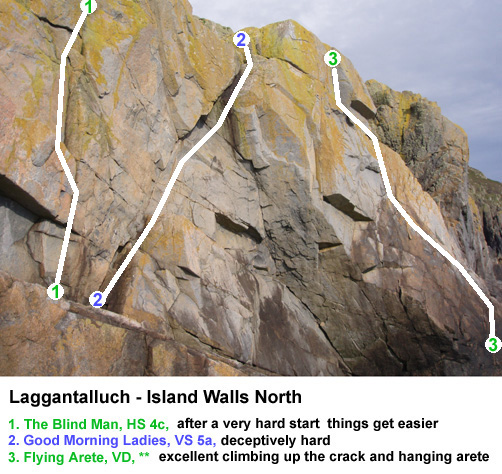
Routes north of the gully are shown on the photo-topo above. The Blind Man, VS 4c, has a very awkward mantelshelf followed by a greasy groove, Good Morning Ladies, VS 5a takes the deceptively hard L to R sloping diagonal crack. The best route here is Flying ArÍte, VD, ** which takes the crack up the broad rib at the south end of the North wall, finishing with a spectacular move L into the top corner achieved by laybacking the arÍte. Beyond Flying ArÍte is the broad ascent/descent gully, an "Easy" scramble.
The routes on the south wall are generally better. First is A Plaice by the Sea, HS 4b, ** . This is the only route on the South wall accessible by the descent gully (and therefore a good place to start). It takes the diagonal crack to a square ledge then the very steep corner above.
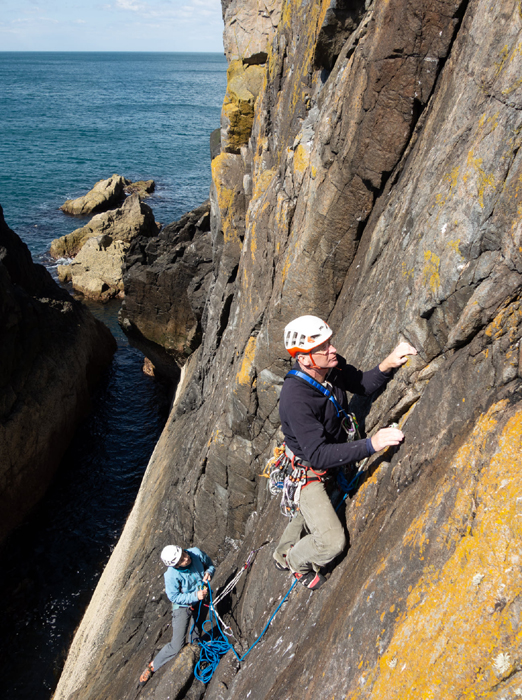
John Biggar leading Fish Tales on the Island Walls at Laggantalluch Head, April 2021. Photo courtesy of Stephen Reid @needlesports.com
The remaining routes require an abseil approach as detailed above. The distinctive feature of this area is the vertical crack/overlap of Little Feat, with the diagonal crack of Fish Tales rising rightwards from the same start. North of these are two routes on the nice wall, Skating VD, * goes up the big square corners and Bouillabaisse, S **, goes up the rib just left of Little Feat. Little Feat, VS 4c, ** takes the central corner and finally Fish Tales S 4a * takes a short diagonal crack to join the long R to L flake line of The Fish Ladder VD which comes in from the extreme R.
It's hard to get a good photo of this crag, but the one below may help a little with locating the starts of the routes.
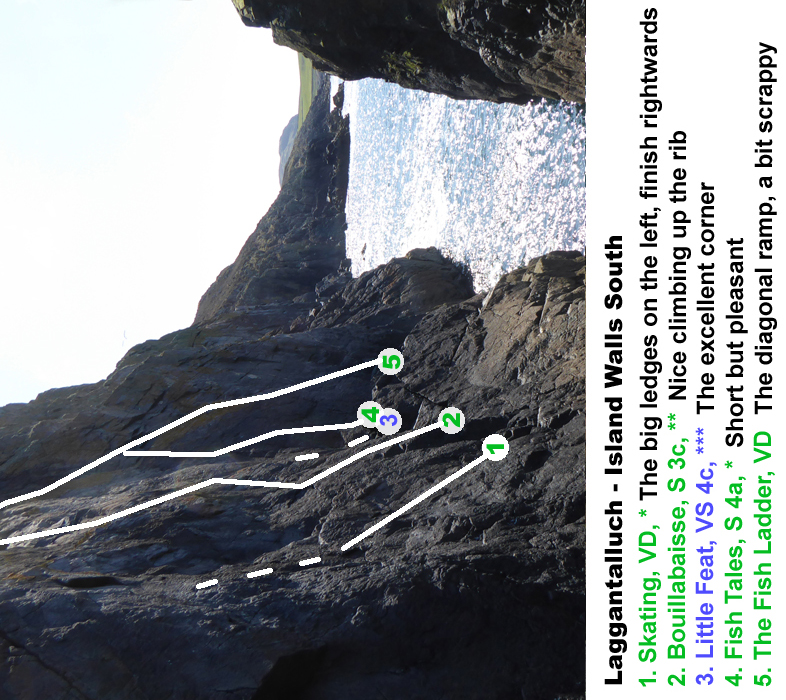
Foaming Hoodlum Area
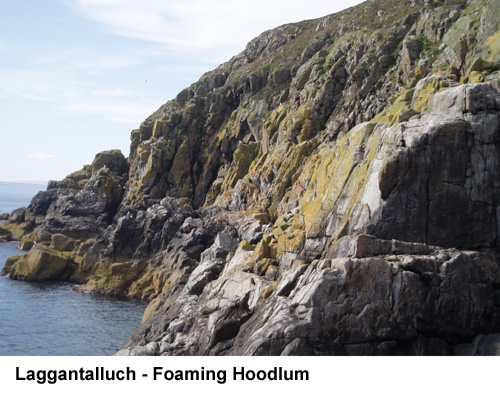
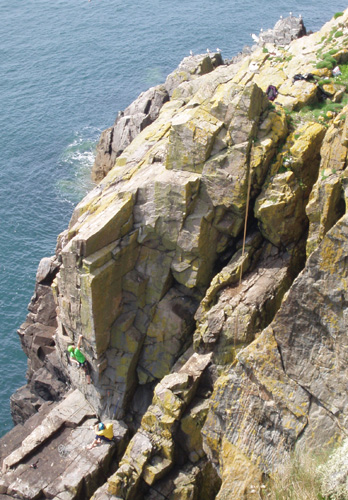
The hard initial moves on Quick Seal, E3, at the Main Cliff area of Laggantalluch, Galloway. You can also see the regular abseil line and gearing up site.!


